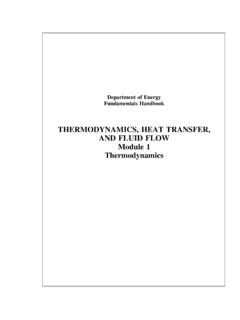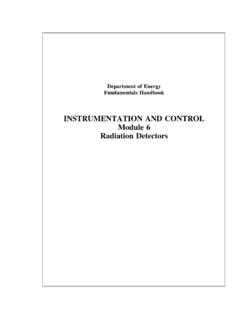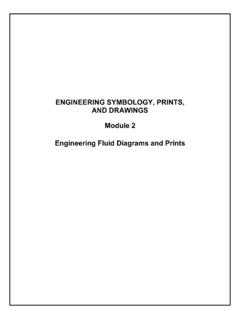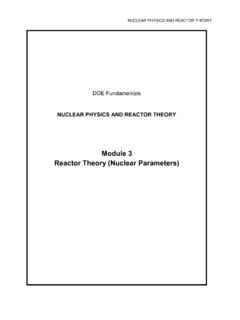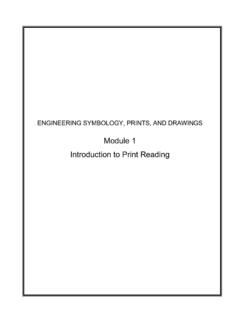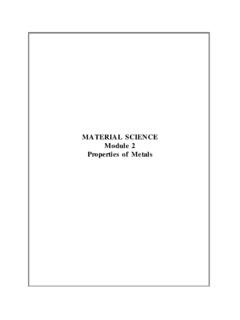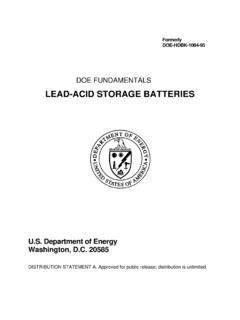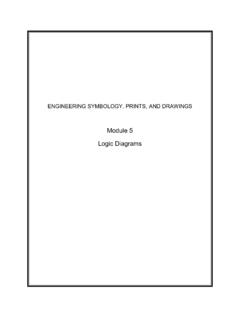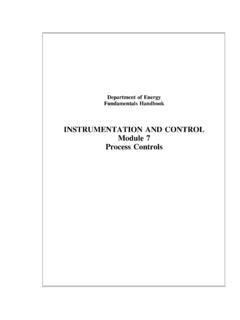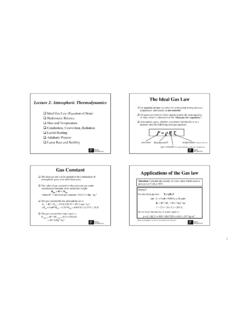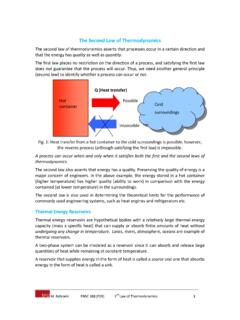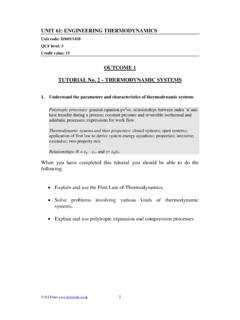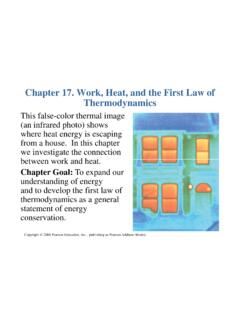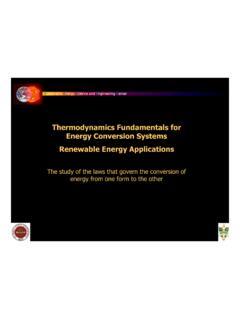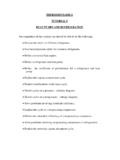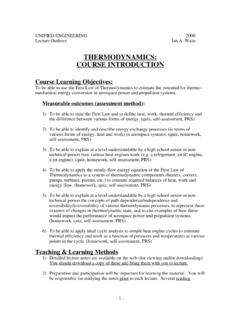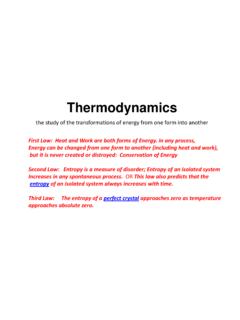Transcription of THERMODYNAMICS, HEAT TRANSFER, AND FLUID FLOW, …
1 Department of EnergyFundamentals HandbookTHERMODYNAMICS, heat TRANSFER, AND FLUID FLOW, Module 3 FLUID FlowblankFluid FlowTABLE OF CONTENTSTABLE OF CONTENTSLIST OF ivLIST OF viiCONTINUITY 1 Properties of 3 Relationship Between Depth and 3 Pascal s 7 Control 8 Volumetric Flow 9 Mass Flow 9 Conservation of 10 Steady-State 10 Continuity 16 LAMINAR AND TURBULENT 17 Flow 17 Laminar 17 Turbulent 17 Flow Velocity 18 Average (Bulk) 19 Ideal 19 Reynolds 20 Rev. 0 Page iHT-03 TABLE OF CONTENTSF luid FlowTABLE OF CONTENTS (Cont.)BERNOULLI S 21 General Energy 21 Simplified Bernoulli 23 Energy Conversions in FLUID 23 Restrictions on the Simplified Bernoulli 25 Extended 25 Application of Bernoulli s Equation to a 30 HEAD 31 Head 31 Friction 31 Darcy s 32 Minor 34 Equivalent Piping 36 NATURAL 37 Forced and Natural 37 Thermal Driving 37 Conditions Required for Natural 38 Example of Natural Circulation 39 Flow Rate and Temperature 40 TWO-PHASE FLUID 41 Two-Phase FLUID 41 Flow 42 Pipe 43 Water 43 Pressure 43 Steam 45 Operational 46HT-03 Page iiRev.
2 0 FLUID FlowTABLE OF CONTENTSTABLE OF CONTENTS (Cont.)CENTRIFUGAL 47 Energy Conversion in a Centrifugal 47 Operating Characteristics of a Centrifugal 48 Net Positive Suction 49 Pump 49 System Characteristic 52 System Operating 52 System Use of Multiple Centrifugal 53 Centrifugal Pumps in 53 Centrifugal Pumps in 56 APPENDIX B FLUID 0 Page iiiHT-03 LIST OF FIGURESF luid FlowLIST OF FIGURESF igure 1 Pressure Versus 3 Figure 2 Pascal s 7 Figure 3 Continuity 12 Figure 4"Y" Configuration for Example 14 Figure 5 Laminar and Turbulent Flow Velocity 18 Figure 6 Venturi 27 Figure 7 Typical Centrifugal Pump Characteristic 48 Figure 8 Changing Speeds for Centrifugal 51 Figure 9 Typical System Head Loss 52 Figure 10 Operating Point for a
3 Centrifugal 52 Figure 11 Pump Characteristic Curve for Two IdenticalCentrifugal Pumps Used in 53 Figure 12 Operating Point for Two Parallel Centrifugal 54 Figure 13 Pump Characteristic Curve for Two IdenticalCentrifugal Pumps Used in 54 Figure 14 Operating Point for Two Centrifugal Pumps in 55 Figure B-1 Moody ivRev. 0 FLUID FlowLIST OF TABLESLIST OF TABLEST able 1 Typical Values 34 LeqDRev. 0 Page vHT-03 REFERENCESF luid FlowREFERENCESS treeter, Victor L., FLUID Mechanics, 5th Edition, McGraw-Hill, New York,ISBN , J. G. and Katz, D. L., FLUID Dynamics and heat Transfer, McGraw-Hill, , A. T. and Fox, R. W., Introduction to FLUID Mechanics, 2nd Edition, JohnWiley and Sons, New York, ISBN Company, Flow of Fluids Through Valves, Fittings, and Pipe, Crane Co.
4 TechnicalPaper No. 410, Chicago, Illinois, , Anthony, FLUID Power with Applications, Prentice-Hall, Inc., New Jersey, , Graham, One-Dimensional Two-Phase Flow, McGraw-Hill, New York, Program for Nuclear Power Plant Personnel, Volume III and IV,General Physics Corporation, Library of Congress Card #A 397747, June 1982 andApril viRev. 0 FLUID FlowOBJECTIVESTERMINAL conditions affecting the FLUID flow in a system,EVALUATEthe effects onthe operation of the the density of a FLUID varies with term relationship between the pressure in a FLUID column and the density anddepth of the s terms mass flow rate and volumetric flow the mass flow rate or the volumetric flow rate for a FLUID principle of conservation of FLUID velocity or flow rate in a specified FLUID system using thecontinuity characteristics and flow velocity profiles of laminar flow and property of the viscosity of a FLUID varies with characteristics of an ideal relationship between the Reynolds number and the degree of turbulenceof the relationship between Bernoulli s equation and the First Law 0 Page viiHT-03 OBJECTIVESF luid
5 FlowENABLING OBJECTIVES (Cont.) term head with respect to its use in FLUID energy conversions that take place in a FLUID system between the velocity,elevation, and pressure heads as flow continues through a piping the initial and final conditions of the system,CALCULATEthe unknown fluidproperties using the simplified Bernoulli restrictions applied to Bernoulli s equation when presented in its to extend the Bernoulli equation to more general s principle to the operation of a terms head loss, frictional loss, and minor factors for various flow situations using the Moody head loss in a FLUID system due to frictional losses using Darcy equivalent length of pipe that would cause the same head loss as theminor losses that occur in individual circulation and forced driving conditions necessary for natural circulation to relationship between flow rate and temperature difference in naturalcirculation the operator can determine whether natural circulation exists in thereactor coolant system and other heat removal to enhance natural circulation viiiRev.
6 0 FLUID FlowOBJECTIVESENABLING OBJECTIVES (Cont.) flow including such phenomena as bubbly, slug, and annular problems associated with core flow oscillations and flow conditions that could lead to core flow oscillation and phenomenon of pipe phenomenon of water terms net positive suction head and new volumetric flow rate, head, or power for a variable speedcentrifugal pump using the pump effect on system flow and pump head for the following pump pumps in pumps in seriesRev. 0 Page ixHT-03 FLUID FlowIntentionally Left BlankHT-03 Page xRev. 0 FLUID FlowCONTINUITY EQUATIONCONTINUITY EQUATIONU nderstanding the quantities measured by the volumetric flow rateand mass flow rate is crucial to understanding other FLUID flow continuity equation expresses the relationship between mass flowrates at different points in a FLUID system under steady-state how the density of a FLUID varies with the term the relationship between the pressure in afluid column and the density and depth of the Pascal s the terms mass flow rate and volumetric either the mass flow rate or thevolumetric flow rate for a FLUID the principle of conservation of the FLUID velocity or flow rate in aspecified FLUID system using the continuity
7 Flow is an important part of most industrial processes; especially those involving thetransfer of heat . Frequently, when it is desired to remove heat from the point at which it isgenerated, some type of FLUID is involved in the heat transfer process. Examples of this are thecooling water circulated through a gasoline or diesel engine, the air flow past the windings ofa motor, and the flow of water through the core of a nuclear reactor. FLUID flow systems are alsocommonly used to provide flow in the nuclear field can be complex and is not always subject to rigorous mathematicalanalysis. Unlike solids, the particles of fluids move through piping and components at differentvelocities and are often subjected to different 0 Page 1HT-03 CONTINUITY EQUATIONF luid FlowEven though a detailed analysis of FLUID flow can be extremely difficult, the basic conceptsinvolved in FLUID flow problems are fairly straightforward.
8 These basic concepts can be appliedin solving FLUID flow problems through the use of simplifying assumptions and average values,where appropriate. Even though this type of analysis would not be sufficient in the engineeringdesign of systems, it is very useful in understanding the operation of systems and predicting theapproximate response of FLUID systems to changes in operating basic principles of FLUID flow include three concepts or principles; the first two of which thestudent has been exposed to in previous manuals. The first is the principle of momentum(leading to equations of FLUID forces) which was covered in the manual on Classical Physics. Thesecond is the conservation of energy (leading to the First Law of thermodynamics ) which wasstudied in thermodynamics .
9 The third is the conservation of mass (leading to the continuityequation) which will be explained in this of FluidsAfluidis any substance which flows because its particles are not rigidly attached to one includes liquids, gases and even some materials which are normally considered solids, suchas glass. Essentially, fluids are materials which have no repeating crystalline properties of fluids were discussed in the thermodynamics section of this text. Theseincluded temperature, pressure, mass, specific volume and defined asthe relative measure of how hot or cold a material is. It can be used to predict the direction thatheat will be defined as the force per unit area. Common units forpressure are pounds force per square inch (psi).
10 Masswas defined as the quantity of mattercontained in a body and is to be distinguished from weight, which is measured by the pull ofgravity on a body. Thespecific volumeof a substance is the volume per unit mass of thesubstance. Typical units are ft3 , on the other hand, is the mass of a substance perunit volume. Typical units are lbm/ft3. Density and specific volume are the inverse of oneanother. Both density and specific volume are dependant on the temperature and somewhat onthe pressure of the FLUID . As the temperature of the FLUID increases, the density decreases and thespecific volume increases. Since liquids are considered incompressible, an increase in pressurewill result in no change in density or specific volume of the liquid.
